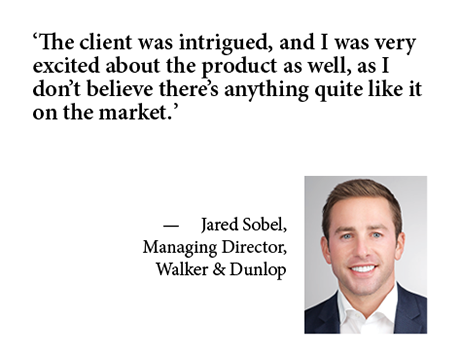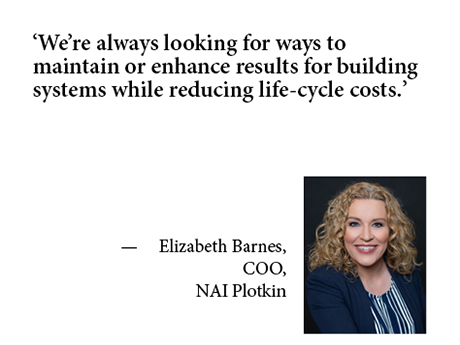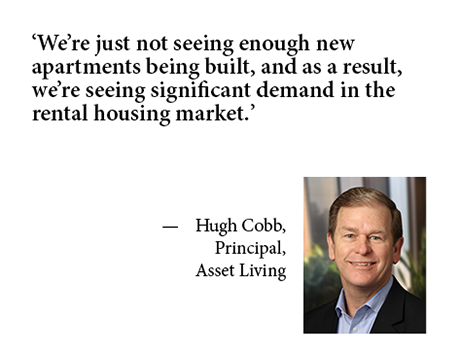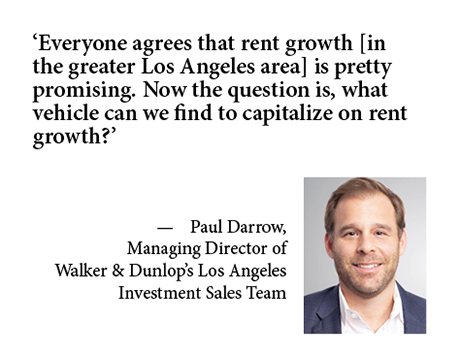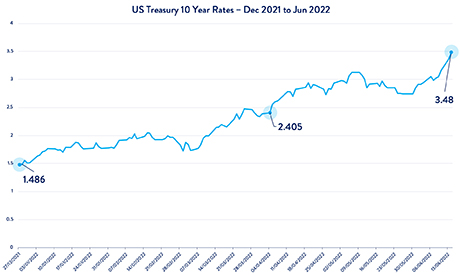Following a similar move in June and July, the Fed implemented its third consecutive interest rate hike of 75 basis points in mid-September. This is the biggest three-month interest rate swing since 1994. What does this all mean for investors in the small balance lending (SBL) segment of the multifamily sector? The combination of rising interest rates, inflation and market uncertainty tempts borrowers to sit on the sidelines until conditions improve. Turbulent markets also limit financing options, as many lenders and capital sources tend to become cautious and pull back. But the need for capital transcends market cycles and seasoned multifamily investors know that rate hikes are nothing new. We’ve been here before with interest rates of nearly 7 percent in the 2000s and a record high of nearly 20 percent in the 1980s. The business of real estate investing never stops. New acquisition opportunities arise as distressed owners are forced to sell, cap rates settle to more conservative levels and the market shifts in the buyer’s favor. All things considered, now is the time to seek new investment opportunities. In fact, Warren Buffett once offered the timeless advice that it is wise for investors to be “fearful when others …
Content Partner
AcquisitionsContent PartnerDevelopmentFeaturesLoansMidwestMultifamilyNortheastSoutheastTexasWalker & DunlopWestern
Combinations of offices with laboratories, research and development spaces and/or manufacturing areas make life sciences facilities highly customizable. These multipurpose, technical spaces are in high demand from companies seeking first-class facilities for research-based advancements. Low vacancies, high rents and the chance to convert unused office or retail spaces on a faster timeline have prompted some creative approaches to retrofit existing space to fulfill the needs of science and technology tenants. In other instances, facilities must be built from the ground up to conform to best practices. But what factors matter most to the life sciences field? And how can developers increase their speed to market? Read on for tips and checklists for developers hoping to speed up the process of building or retrofitting these facilities. Industry Drivers: Speed to Market and Flexibility Office conversions into life sciences facilities offer a variety of options. Life sciences facilities often do not need to accommodate large trucks (eliminating circulation and loading dock concerns), they use office components and (most importantly) office conversions offer faster speed to market than other types of conversions. “Speed to market is most important for these developers/tenants. There is a shortage of space, so a well-designed, spec building will …
Elizabeth Barnes, COO of NAI Plotkin, knows property management is always a labor- and people-intensive profession, no matter the day or time of year. In that regard, the pandemic did not change the best practices for the Springfield, Mass.-based full-service brokerage and management company. “The number-one best practice has always been — and remains to this day — to manage the property as if you own it, with the awareness that you don’t,” Barnes says. Treat the Asset as Your Own For Barnes, this means focusing on the asset’s value at all times. “Common area maintenance (CAM) reconciliation, capital planning, value engineering options — they need to be front and center,” she continues. “It’s not just about cutting expenses. Look at how you can add value or reduce upfront costs.” All this should be done, she states, with the owner’s goals for the property in mind. Those goals may differ based on whether the owner is, for example, looking to divest the asset. Or if the tenant’s space has gone dark. Or if a pandemic is occurring. “There is a definite focus on health and safety now, regardless of the product type,” Barnes says. “Many owners wanted HVAC and air-handling …
The landscape of multifamily Internet access is changing rapidly, driven by evolving resident expectations. No longer merely a utility, reliable Wi-Fi and Ethernet connections are essential for attracting and retaining residents, along with cutting operation costs. Expanding connectivity needs, work-from-home (WFH) culture and growing interest in smart-home applications are all driving residents’ Internet requirements. The centrality of Internet access for multifamily residents was inevitable in the long run, according to Bryan Rader, president of Multi-Dwelling Units (MDU) at Pavlov Media. COVID lockdowns accelerated an already burgeoning trend: bulk-managed Internet designed to improve connections and simplify growing demand. Bulk-managed connectivity offers a variety of solutions for on-site managers, residents and owners, as well as cost savings in unexpected areas. This approach provides building-wide Internet connections through a single provider, rather than asking residents to sign up individually with one of several Internet providers. The bulk Internet management company may also install and manage the building’s connection infrastructure. The simplicity of bulk-managed Internet (which started as bulk-managed Wi-Fi in student housing) is becoming increasingly practical for multifamily buildings. In the last four or five years, the traditional multifamily industry is starting to follow the same model that became standard in student housing …
As the commercial real estate market adjusts to how much of an effect higher interest rates will have on investment sales and property values, the rental housing sector continues to witness robust resident demand and rent growth as home ownership has become even more difficult for first-time buyers. According to a recent report by the National Multifamily Council (NMHC) and the National Apartment Association (NAA), by 2035 the U.S. needs to build 4.3 million new residential rentals to meet housing needs amid shifting demographics, the existing shortage and the loss of 4.7 million affordable units with monthly rental rates of $1,000 or less, the organizations report. “We’re just not seeing enough new apartments being built, and as a result, we’re seeing significant demand in the rental housing market,” says Hugh Cobb, a principal of Asset Living, one of the nation’s largest property managers of multifamily, affordable, student, active adult, single-family rentals and build-to-rent housing. “Because we’re seeing a decrease in demand in the single-family sales market due to higher mortgage rates, people are staying in apartments longer. And as their families grow, they’re looking for alternative rental housing, such as the build-to-rent space,” says Hugh Cobb. “Through our proprietary data …
AcquisitionsCaliforniaContent PartnerDevelopmentFeaturesLeasing ActivityMultifamilyWalker & DunlopWestern
LA Multifamily Investment Deals See Volume Normalization, Pricing Resets for Select Assets
Multifamily investment transaction volume had an unprecedented year in 2021, and the first six months of 2022 were quite robust. Now, economic uncertainty in the form of rising interest rates and a cooling economy has created some hesitancy on the part of investors. “Some normalization is occurring in the market now, in addition to a pullback because of what is going on in the capital markets and economy,” says Paul Darrow, a managing director of Walker & Dunlop’s investment sales team based out of Los Angeles. Walker & Dunlop is one of the largest providers of capital to commercial real estate industry in the United States. Darrow sat down with REBusinessOnline to talk about multifamily investment sales trends in the Los Angeles area and the opportunities he sees for investors down the road. REBusiness: Investor interests have shifted in the past few months. What kinds of properties are investors most interested in now? Darrow: It’s a mixed bag when it comes to investor appetite. Those who raised money to buy specific types of buildings are obviously guided by what they’ve promised their investors in the form of return profiles and risk. Core funds, for example, can’t just switch to value-add or …
BohlerContent PartnerDevelopmentFeaturesLeasing ActivityMidwestMultifamilyNortheastSoutheastTexasWestern
Multifamily Developers Must Find Balance Between Density, Amenities
Finding a balance between density and amenities has never been simple for residential developers, but rising interest rates, density restrictions and an increased desire to solidify multifamily projects within the community mean that there is much to be gained from creative approaches to this old problem. Starting the process of planning early, using zoning to the developer’s advantage and creating an adaptable, sustainable and welcoming place for tenants can allow for a successful project with a lower overall price tag. This method can solve some of the trickier problems faced by multifamily developers, including density, parking and zoning considerations. Starting Off Right — Creating a Master Site Plan Success in multifamily is easier to achieve if the project starts with a shared team vision from the outset, says Bill Rearden, principal at Bohler, a land development design and consulting firm. Rearden explains that Bohler has its own planning, landscape architecture and survey teams and works with many industry partners for environmental and geotechnical due diligence. “We work with these teams in the very early stages to understand what the configuration of a property is and what its constraints are. We know upfront any underlying zoning a property might have, so …
Arbor Realty TrustContent PartnerFeaturesLeasing ActivityMidwestMultifamilyNortheastSoutheastTexasWestern
Arbor: Multifamily Market Well-Positioned to Withstand Economic Headwinds
While rising interest rates, inflation and economic volatility have hurt many sectors of the economy, the rental housing market has maintained solid footing, according to Arbor Realty Trust’s Summer 2022 Special Report: Rental Housing Market Exhibits Cyclical Stability, Contains Structural Questions. The report was written by Ivan Kaufman, Arbor’s chairman and CEO, and Sam Chandan, founder of Chandan Economics. In a time of economic uncertainty, renting has become more appealing. Households seeking an affordable place to live, those who are delaying homeownership and others who prefer the flexibility and amenities associated with multifamily units all add to the increasing numbers of potential renters. Less traditional factors may also increase interest in renting, especially outside of tier-one markets. The expansion of work-from-home (WFH) culture is likely to be another reason rental demand is high right now. Meanwhile, the flexibility to work where the cost of living is lower and space is at less of a premium is pushing some renters who work remotely to explore living outside traditional hotspots. Economic Uncertainty Spreads as Interest Rate, Inflation Rise The Arbor Realty Trust report highlights a host of factors that are leading to economic uncertainty. Inflation (and its secondary effects) are contributing to …
Amazon recently reconfigured and consolidated its network of warehouses, and many other retailers followed suit. The result? The outlook for industrial real estate, particularly retail warehouses, is now more difficult to interpret. Many retail clients are repositioning their supply chains to help avoid slowdowns and a potential International Warehouse Logistics Association (IWLA) union strike on the West Coast. This change has merged with a corporate need to find additional options for shipping and transport (especially as prices for transportation and industrial rents rise). The demand for industrial space has increased rapidly in less “congested” areas. As economic uncertainty continues, there is a shift towards tertiary markets for industrial real estate. This change provides significant opportunities for industrial investors, says Steve Pastor, VP of global supply chain, and ports/rail logistics/consultant at NAI James E. Hanson, who serves as NAI Global Industrial Council Chair. Investors and developers may be able to take advantage of a pause in a highly competitive field, in tertiary markets that have been traditionally less expensive than major and core markets. Amazon’s Impact News of Amazon’s plans to scale back its acquisition of industrial space (and to sublease its existing property to other retailers) has given some users opportunities …
Content PartnerFeaturesLeasing ActivityLoansMidwestMultifamilyNortheastSoutheastTexasWalker & DunlopWestern
How to Maintain Multifamily Investment Momentum in the Face of Rising Interest Rates
By Melissa Jahnke, associate director of operations, Walker & Dunlop The Federal Reserve raised interest rates by 75 basis points in June and then another 75 basis points in July, sending shockwaves across the commercial real estate industry. Fortunately, there are opportunities and solutions to bypass these potential roadblocks. Specifically, investors in a segment of multifamily housing known as small balance lending (SBL), encompassing five- to 150-unit properties, have several options to realize their aspirations for financing multifamily portfolios. View a higher resolution version of the timeline above here. During a recent webcast “Financing Amid Rising Rates: Best Approaches for $1M-$15M Multifamily Loans,” Walker & Dunlop’s market experts spoke about navigating today’s financing landscape. The expert panel included Allison Williams, senior vice president and chief production officer; Allison Herrera, senior director of SBL; and Tim Cotter, director of capital markets. These experienced professionals have found ways to make deals happen in a wide variety of financing environments and have shared their perspectives and guidance. If you are an owner of five- to 150-unit properties that require loans between $1 million to $15 million, the following will help you navigate today’s financial environment and build your momentum. Step 1: Consider the …


